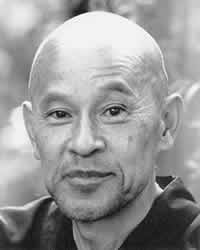 Reflections
on Shunryu Suzuki
Reflections
on Shunryu Suzukicuke.com - Shunryu Suzuki Index - WHAT'S NEW - table of contents
 Reflections
on Shunryu Suzuki
Reflections
on Shunryu Suzuki
7 Practices That Restored My Buddhist FaithLewis Richmond Starting in my early 20s, I immersed myself in the study of Soto Zen, first with my Japanese root teacher, and after his death with his American successor. I lived in monastic or semi-monastic settings for a total of 15 years. Early on I was ordained as a priest; at some point I became a teacher myself. During that time, Buddhism was my whole life. Then, after 15 years my faith in this practice, once so strong, turned to doubt. I began asking myself: What do I really know that is true? Who and what can I really trust? I also asked: What has become of Lew, the person I used to be so many years before? I felt I needed to re-examine everything. I took off my robes, left my teaching position and my residential community. I rented a house in town, got a job, and set about living an ordinary life with my wife and 9-year-old son. I began taking apart the "carburetor" of who I was and painstakingly re-assembling it, piece by piece. Each time I picked up a piece, I had to ask, what is this? Can I trust it? Out of this lengthy period of self-examination I came up with seven foundational practices in Buddhism that I felt I could really trust, that were solid, trustworthy and effective. These were: Sitting, Walking, Chanting, Bowing, Precepts, Robe and Sutra. I can't say that all seven are universal to every school of Buddhism, but many of them are, and all of them are common to the meditation schools of the three vehicles -- Theravada, Mahayana and Vajrayana. Sitting Sitting was the core practice of the Buddha, the one that led to his enlightenment under the Bo tree. Sitting is also the main practice of Zen. During my many years of residential practice, I sometimes felt betrayed by people or by teachers, and even by the teachings they offered, but I was never betrayed by sitting practice itself. It was foundational. Walking The Buddha taught the "four postures" -- walking, standing, sitting and lying down. These four postures pretty much include all activities; the four postures means expressing mindful awareness in every aspect of life. Walking can be a kind of meditation and expression of mindful awareness; in Zen walking alternates with walking in long retreats. There is also circumambulation - -walking in a clockwise circle as an act of veneration --a s one of the oldest Buddist practices. Chanting Chanting is not just Buddhist. People of all religions chant or sing. For most Buddhists today, chanting -- whether a mantra, a sutra, the name of Buddha or the name of a sutra -- is their primary practice. When I first came to my teacher's temple in San Francisco's Japantown, there was a sign posted outside the meditation hall: "Chant with your Ears." That seemed rather mysterious until one day my teacher explained it this way: When you chant with your ears, ego is set aside and everyone's chanting fills your own body. Bowing My teacher loved bowing. He used to say that we should be prepared to bow in our last moment. Buddhists bow to each other and to Buddha, but this is not idol worship. Buddha is not a god, but a representation of the highest ideal of a human being. In the deepest sense, we don't really bow to anything; we just bow. "The mast of your ego becomes horizontal when you bow," my teacher said. Precepts Buddhism is at root an ethical teaching, a way to live harmoniously in the world with others without causing unnecessary harm. All the precepts boil down to one teaching: ahimsa or non-harm. Thich Nhat Hanh reportedly was asked once to summarize Buddhism in one word, and said, "Ahimsa." I have never heard of a Buddhist sect or tradition that rejects this principle. Robe These days I wear my priest robes for ceremonies and meditation; otherwise I dress like anyone else. Most Buddhist laypeople do not wear a robe -- though a mala, or Buddhist rosary, can be thought of as a kind of robe. In a metaphorical sense, the robe means the protection or container of Buddhist practice. Precepts are kind of robe, and when lay Buddhists formally receive the precepts in many traditions they are given a small robe. My teacher also taught the "formless robe," the robe you can't see but that you "wear" through practice and faith. Sutra The sutras are the sermons and teachings of the Buddha and his successors. Sutras are the written expression of Buddhism. I have studied the sutras my whole life. The sutras are the living record of the generations of wisdom seekers that make up the 2,500 history of Buddhism. The word "sutra" in Sanskrit literally means "thread," and originally referred to the thread that bound the palm leaves on which sutras were written. Sutra can also mean the thread that connects us with Buddhism's past, and with all Buddhists living today. In that sense sutra means lineage and connection. These are the seven foundational practices that rescued my practice and brought me back to my faith in it. |